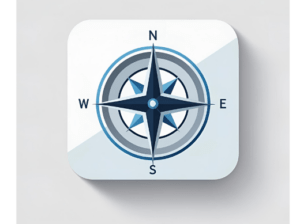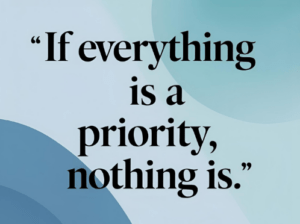8 Strategic Planning Tips From an Implementation Pro
Strategic planning often gets a bad rap.
For most organizations, a strategic plan is a document that gets dusted off once a year—created to meet a mandate, satisfy a board, or check a compliance box. But in reality, when done right, strategic planning is a powerful daily discipline that can unify teams, sharpen focus, and drive meaningful results.

In one of ACJI’s recent Learn@Work LIVE Webinars, we sat down with Nicholas K. Powell, PhD, Georgia Department of Community Supervision, who leads strategic planning efforts and brings an implementation science lens to the work. His insights are a masterclass in how to turn planning from paperwork into practice—and these lessons apply to any mission-driven organization but are especially useful for probation and parole agencies.
We’ve embedded the full webinar here, but if you’d like to read the highlights, keep scrolling beyond the video.
8 Strategic Planning Tips
1. Strategic Planning Is a Discipline, Not a Document
Most organizations create strategic plans like term papers—write them, turn them in, and move on.

But that mindset leads to dusty binders and disconnected goals. Instead, strategic planning should be a living, breathing part of how decisions are made every single day. Especially when resources are tight or the pressure is high, a strategic mindset keeps teams from falling into reactivity.
Tip: Treat your strategic plan like a compass, not a report. Revisit it often, not annually.
Your mission is why you exist. Your vision is what you want to become. Every action you take—whether hiring, launching a pilot, or spending down end-of-year funds—should connect clearly to both.
When time and attention are stretched, leaders who use their mission and vision as a North Star make stronger, more consistent decisions.
Tip: When faced with competing priorities, ask: Which one moves us closer to our mission and vision?
3. Control the Controllables
Agencies often focus on big outcomes—employment rates, recidivism, homelessness—that are influenced by countless external factors. The problem? Your staff can’t directly control those things.
Instead, shift your focus to the actions your team can take that contribute to better outcomes: making timely referrals, following up, building relationships, and using evidence-based practices.
Tip: Redefine success as doing the right work—not just achieving the right outcome.
4. The Art of Sacrifice: Strategy Requires Trade-Offs
Being strategic means saying no. It means choosing the few things that matter most and putting full weight behind them—rather than spreading people and resources thin across a dozen disconnected initiatives.

If everything is a priority, nothing is. Even more important is the fact that the more we try to do, the less we get done.
Tip: Build the muscle of respectfully saying no to non-mission-critical work—even when it’s “good.”
5. Build Implementation Capacity
It’s easy to fall in love with bold ideas. But successful strategies require more than a good plan—they need capacity.
Do your teams have the time, training, leadership support, and infrastructure to carry out what you’re asking of them? If not, you’re setting them up for failure, and in turn, frustration.
Tip: Before launching something new, ask: Have we made it possible for this to succeed?
6. Get Back to Basics to Go Deeper
Trying to be everything to everyone can dilute your impact. Often, the deepest improvements come when agencies narrow their focus and recommit to their core work — their mission and vision.
That may mean letting go of adjacent responsibilities and trusting partner systems to do their part. It also means investing in systems, supports, and structures that help your staff do their work better.
Tip: Stay in your lane—and drive it better than anyone else.
7. Center Frontline Staff
Your best strategies will fall flat without the buy-in and engagement of the people carrying them out.
Frontline staff aren’t just implementers—they’re your best source of insight on what’s working and what needs to change.Supporting their well-being, professional identity, and decision-making is not a side project—it’s a critical element of strategy.
Tip: Listen closely to what staff are telling you—even if it comes out as a complaint. It’s often a clue to what’s really happening.

8. Let People Own the Work
One of the most powerful shifts a leader can make is to stop micromanaging strategy and start building shared ownership. Once a plan is in place, don’t hoard the work—hand it off. The people closest to the work will bring it to life in ways leadership can’t.
Tip: If you want people to “buy-in,” give them something to own.
Bonus: Use Data to Learn, Not Just to Prove
Strategic planning doesn’t end when the plan is written. It continues through daily measurement and reflection.
Use data not just to show success, but to learn from missteps. When something isn’t working, pivot. Real strategy is adaptive.
Tip: If your data reveals a strategy isn’t effective, that’s not failure—it’s a chance to adjust and improve.
Final Thoughts
Strategic planning isn’t about producing a document—it’s about leading with intention. It’s about choosing the problems you want and the actions you focus on to guide your organization by design, not default.
Whether you’re in criminal justice, health, education, or any mission-driven field, the same truth applies: when planning becomes a shared, implementation-driven discipline, it transforms how your agency works from the inside out.
At ACJI, we help leaders create strategies that don’t just sound good on paper—but actually work in practice. Dr. Nicholas Powell coaches ACJI clients through strategic planning grounded in implementation science, helping teams stay mission-focused and aligned every step of the way. Let’s talk about how we can help your team. Contact us today.





